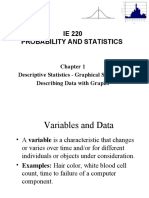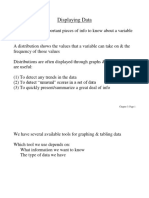0% found this document useful (0 votes)
35 views22 pagesChapter 1 Lecture Slides
This document discusses different types of graphs that can be used to visualize data distributions, including pie charts, bar graphs, histograms, and stem plots. It covers categorical variables that can be shown with pie charts or bar graphs, and quantitative variables that can be depicted using histograms or stem plots. The document provides examples and explanations of how to interpret these various graph types and analyze distributions.
Uploaded by
Daneen BaigCopyright
© © All Rights Reserved
We take content rights seriously. If you suspect this is your content, claim it here.
Available Formats
Download as PDF, TXT or read online on Scribd
0% found this document useful (0 votes)
35 views22 pagesChapter 1 Lecture Slides
This document discusses different types of graphs that can be used to visualize data distributions, including pie charts, bar graphs, histograms, and stem plots. It covers categorical variables that can be shown with pie charts or bar graphs, and quantitative variables that can be depicted using histograms or stem plots. The document provides examples and explanations of how to interpret these various graph types and analyze distributions.
Uploaded by
Daneen BaigCopyright
© © All Rights Reserved
We take content rights seriously. If you suspect this is your content, claim it here.
Available Formats
Download as PDF, TXT or read online on Scribd
/ 22

























































